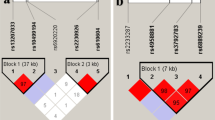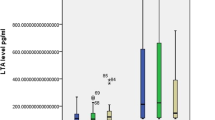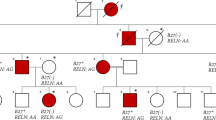Abstract
The mechanism by which human leukocyte antigen B27 (HLA-B27) contributes to ankylosing spondylitis (AS) remains unclear. Genetic studies demonstrate that association with and interaction between polymorphisms of endoplasmic reticulum aminopeptidase 1 (ERAP1) and HLA-B27 influence the risk of AS. It has been hypothesised that ERAP1-mediated HLA-B27 misfolding increases endoplasmic reticulum (ER) stress, driving an interleukin (IL) 23-dependent, pro-inflammatory immune response. We tested the hypothesis that AS-risk ERAP1 variants increase ER-stress and concomitant pro-inflammatory cytokine production in HLA-B27+ but not HLA-B27− AS patients or controls. Forty-nine AS cases and 22 healthy controls were grouped according to HLA-B27 status and AS-associated ERAP1 rs30187 genotypes: HLA-B27+ERAP1risk, HLA-B27+ERAP1protective, HLA-B27−ERAP1risk and HLA-B27−ERAP1protective. Expression levels of ER-stress markers GRP78 (8 kDa glucose-regulated protein), CHOP (C/EBP-homologous protein) and inflammatory cytokines were determined in peripheral blood mononuclear cell and ileal biopsies. We found no differences in ER-stress gene expression between HLA-B27+ and HLA-B27− cases or healthy controls, or between cases or controls stratified by carriage of ERAP1 risk or protective alleles in the presence or absence of HLA-B27. No differences were observed between expression of IL17A or TNF (tumour necrosis factor) in HLA-B27+ERAP1risk, HLA-B27+ERAP1protective and HLA-B27−ERAP1protective cases. These data demonstrate that aberrant ERAP1 activity and HLA-B27 carriage does not alter ER-stress levels in AS, suggesting that ERAP1 and HLA-B27 may influence disease susceptibility through other mechanisms.
This is a preview of subscription content, access via your institution
Access options
Subscribe to this journal
Receive 6 digital issues and online access to articles
$119.00 per year
only $19.83 per issue
Buy this article
- Purchase on Springer Link
- Instant access to full article PDF
Prices may be subject to local taxes which are calculated during checkout





Similar content being viewed by others
References
Brown MA, Kennedy LG, MacGregor AJ, Darke C, Duncan E, Shatford JL et al. Susceptibility to ankylosing spondylitis in twins: the role of genes, HLA, and the environment. Arthritis Rheum 1997; 40: 1823–1828
Evans DM, Spencer CC, Pointon JJ, Su Z, Harvey D, Kochan G et al. Interaction between ERAP1 and HLA-B27 in ankylosing spondylitis implicates peptide handling in the mechanism for HLA-B27 in disease susceptibility. Nat Genet 2011; 43: 761–767
Cui X, Hawari F, Alsaaty S, Lawrence M, Combs CA, Geng W et al. Identification of ARTS-1 as a novel TNFR1-binding protein that promotes TNFR1 ectodomain shedding. J Clin Invest 2002; 110: 515–526
Cui X, Rouhani FN, Hawari F, Levine SJ . Shedding of the type II IL-1 decoy receptor requires a multifunctional aminopeptidase, aminopeptidase regulator of TNF receptor type 1 shedding. J Immunol 2003; 171: 6814–6819
Kollnberger S, Bowness P . The role of B27 heavy chain dimer immune receptor interactions in spondyloarthritis. Adv Exp Med Biol 2009; 649: 277–285
Cortes A, Hadler J, Pointon JP, Robinson PC, Karaderi T, Leo P et al. Identification of multiple risk variants for ankylosing spondylitis through high-density genotyping of immune-related loci. Nat Genet 2013; 45: 730–738.
Haroon N, Tsui FW, Chiu B, Tsui HW, Inman RD . Serum cytokine receptors in ankylosing spondylitis: relationship to inflammatory markers and endoplasmic reticulum aminopeptidase polymorphisms. J Rheumatol 2010; 37: 1907–1910.
Kanaseki T, Blanchard N, Hammer GE, Gonzalez F, Shastri N . ERAAP synergizes with MHC class I molecules to make the final cut in the antigenic peptide precursors in the endoplasmic reticulum. Immunity 2006; 25: 795–806.
Colbert RA, DeLay ML, Klenk EI, Layh-Schmitt G . From HLA-B27 to spondyloarthritis: a journey through the ER. Immunol Rev 2010; 233: 181–202.
Garcia-Medel N, Sanz-Bravo A, Van Nguyen D, Galocha B, Gomez-Molina P, Martin-Esteban A et al. Functional interaction of the ankylosing spondylitis-associated endoplasmic reticulum aminopeptidase 1 polymorphism and HLA-B27 in vivo. Mol Cell Proteomics 2012; 11: 1416–1429.
Reveille JD, Sims AM, Danoy P, Evans DM, Leo P, Pointon JJ et al. Genome-wide association study of ankylosing spondylitis identifies non-MHC susceptibility loci. Nat Genet 2010; 42: 123–127.
Harvey D, Pointon JJ, Evans DM, Karaderi T, Farrar C, Appleton LH et al. Investigating the genetic association between ERAP1 and ankylosing spondylitis. Hum Mol Genet 2009; 18: 4204–4212.
Benjamin R, Parham P . HLA-B27 and disease: a consequence of inadvertent antigen presentation? Rheum Dis Clin North Am 1992; 18: 11–21.
Mear JP, Schreiber KL, Munz C, Zhu X, Stevanovic S, Rammensee HG et al. Misfolding of HLA-B27 as a result of its B pocket suggests a novel mechanism for its role in susceptibility to spondyloarthropathies. J Immunol 1999; 163: 6665–6670.
Turner MJ, Sowders DP, DeLay ML, Mohapatra R, Bai S, Smith JA et al. HLA-B27 misfolding in transgenic rats is associated with activation of the unfolded protein response. J Immunol 2005; 175: 2438–2448.
Dong W, Zhang Y, Yan M, Liu H, Chen Z, Zhu P . Upregulation of 78-kDa glucose-regulated protein in macrophages in peripheral joints of active ankylosing spondylitis. Scand J Rheumatol 2008; 37: 427–434.
Antoniou AN, Lenart I, Guiliano DB . Pathogenicity of misfolded and dimeric HLA-B27 molecules. Int J Rheumatol 2011; 2011: 486856.
Taurog JD, Maika SD, Simmons WA, Breban M, Hammer RE . Susceptibility to inflammatory disease in HLA-B27 transgenic rat lines correlates with the level of B27 expression. J Immunol 1993; 150: 4168–4178.
Oyadomari S, Mori M . Roles of CHOP/GADD153 in endoplasmic reticulum stress. Cell Death Differ 2004; 11: 381–389.
Feng Y, Ding J, Fan CM, Zhu P . Interferon-gamma contributes to HLA-B27-associated unfolded protein response in spondyloarthropathies. J Rheumatol 2012; 39: 574–582.
Robinson PC, Brown MA . Genetics of ankylosing spondylitis. Mol Immunol 2014; 57: 2–11.
May E, Dorris ML, Satumtira N, Iqbal I, Rehman MI, Lightfoot E et al. CD8 alpha beta T cells are not essential to the pathogenesis of arthritis or colitis in HLA-B27 transgenic rats. J Immunol 2003; 170: 1099–1105.
Campbell EC, Fettke F, Bhat S, Morley KD, Powis SJ . Expression of MHC class I dimers and ERAP1 in an ankylosing spondylitis patient cohort. Immunology 2011; 133: 379–385.
Neerinckx B, Carter S, Lories RJ . No evidence for a critical role of the unfolded protein response in synovium and blood of patients with ankylosing spondylitis. Ann Rheum Dis 2013; 73: 629–630.
Bowness P, Ridley A, Shaw J, Chan AT, Wong-Baeza I, Fleming M et al. Th17 cells expressing KIR3DL2+ and responsive to HLA-B27 homodimers are increased in ankylosing spondylitis. J Immunol 2011; 186: 2672–2680.
Costello ME, Elewaut D, Kenna TJ, Brown MA . Microbes, the gut and ankylosing spondylitis. Arthritis Res Ther 2013; 15: 214.
Ciccia F, Accardo-Palumbo A, Rizzo A, Guggino G, Raimondo S, Giardina A et al. Evidence that autophagy, but not the unfolded protein response, regulates the expression of IL-23 in the gut of patients with ankylosing spondylitis and subclinical gut inflammation. Ann Rheum Dis 2014; 73: 1566–1574
Ciccia F, Bombardieri M, Principato A, Giardina A, Tripodo C, Porcasi R et al. Overexpression of interleukin-23, but not interleukin-17, as an immunologic signature of subclinical intestinal inflammation in ankylosing spondylitis. Arthritis Rheum 2009; 60: 955–965.
Acknowledgements
Written informed consent was obtained from patients and controls for publication of this manuscript and accompanying images. We acknowledge the contribution of the subjects who participated in this study. We thank Murray Hargrave for his assistance in the preparation of this manuscript and Dr Helen Benham for helpful discussions. This study was supported by Australian National Health and Medical Research Council (NHMRC) grant #569830. TJK was supported by an AFA-ARA Heald Fellowship, PCR was supported by NHMRC PhD scholarship and MAB was supported by NHMRC Senior Principal Research Fellowship APP1024879.
Author information
Authors and Affiliations
Corresponding authors
Ethics declarations
Competing interests
The authors declare no conflict of interest.
Additional information
Supplementary Information accompanies this paper on Genes and Immunity website
Supplementary information
Rights and permissions
About this article
Cite this article
Kenna, T., Lau, M., Keith, P. et al. Disease-associated polymorphisms in ERAP1 do not alter endoplasmic reticulum stress in patients with ankylosing spondylitis. Genes Immun 16, 35–42 (2015). https://doi.org/10.1038/gene.2014.62
Received:
Revised:
Accepted:
Published:
Issue Date:
DOI: https://doi.org/10.1038/gene.2014.62
This article is cited by
-
HLA-B27 may modulate the interaction between ERAP1 polymorphisms and smoking in ankylosing spondylitis patients
Molecular Biology Reports (2022)
-
HLA associations in inflammatory arthritis: emerging mechanisms and clinical implications
Nature Reviews Rheumatology (2019)
-
Ankylosing spondylitis: etiology, pathogenesis, and treatments
Bone Research (2019)
-
Stress proteins in the pathogenesis of spondyloarthritis
Rheumatology International (2019)
-
Pathogenesis of ankylosing spondylitis — recent advances and future directions
Nature Reviews Rheumatology (2017)



